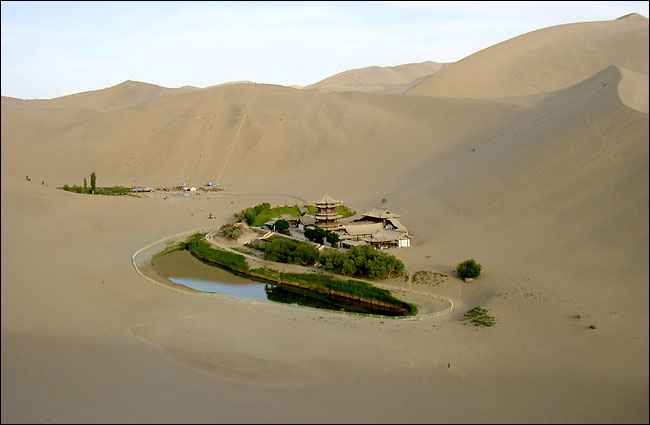Dunhuang City is located at the west part of Hexi Corridor, Gansu Province. It was called Shazhou (sandbank) in ancient time.
Dunhuang City is famous for its historical culture of China and an important ancient city on Silk Road in ancient time. The snow melt water of the Qilian Mountain covered with a expanse of white snow, flows into the Dang River, along which the green land has formed gradually.
When the prefecture was established here from the Han Dynasty, Dunhuang then became the hub of communication, junction of economic and cultural exchange in Gobi Desert between China and western countries and the starting point of three Silk Roads leading to Xiyu (western regions, a Han Dynasty term for the area west of Yumenguan, including what is now Xinjiang and parts of Central Asia). The silk and China invented paper of the Han Dynasty were disseminated from Dunhuang to Persia and Europe passing through desert.
The Budhism of India was spread to the Central Plains (comprising the middle and lower reaches of the Huanghe River). Being as a gate of the Central Plains, Dunhuang received monks and priests of preaching religions from the west and Chinese monks seeking Sutra to India. At that time many temples and churches were established and the cave arts were introduced from India. In Dunhuang, not only lived national minorities of China, but also foreigners from Iran and India mingled with, thus being a prosperous metropolis bustling with activities.
The caves of Mogaoku have fused Budhist arts indigenous and alien, which reflect the achievements of ancient architecture, painting and sculpture. This is the treasure-house of arts, biggest and richest in content reserved in China now. Besides, there are places of historic interest and scenic beauty like Shazhou ancient city, Great Wall built in the Han Dynasty, Yangguan ancient city and Yumen Pass etc. The traditional famous specialties are Dunhuang carpet, Ming Mountain large dates, Zhiyan peach and grape etc. The main communication of Dunhuang City is highway. It has airliner connection with Lanzhou, Xi'an and Urumqi cities.












Dunhuang City is famous for its historical culture of China and an important ancient city on Silk Road in ancient time. The snow melt water of the Qilian Mountain covered with a expanse of white snow, flows into the Dang River, along which the green land has formed gradually.
When the prefecture was established here from the Han Dynasty, Dunhuang then became the hub of communication, junction of economic and cultural exchange in Gobi Desert between China and western countries and the starting point of three Silk Roads leading to Xiyu (western regions, a Han Dynasty term for the area west of Yumenguan, including what is now Xinjiang and parts of Central Asia). The silk and China invented paper of the Han Dynasty were disseminated from Dunhuang to Persia and Europe passing through desert.
The Budhism of India was spread to the Central Plains (comprising the middle and lower reaches of the Huanghe River). Being as a gate of the Central Plains, Dunhuang received monks and priests of preaching religions from the west and Chinese monks seeking Sutra to India. At that time many temples and churches were established and the cave arts were introduced from India. In Dunhuang, not only lived national minorities of China, but also foreigners from Iran and India mingled with, thus being a prosperous metropolis bustling with activities.
The caves of Mogaoku have fused Budhist arts indigenous and alien, which reflect the achievements of ancient architecture, painting and sculpture. This is the treasure-house of arts, biggest and richest in content reserved in China now. Besides, there are places of historic interest and scenic beauty like Shazhou ancient city, Great Wall built in the Han Dynasty, Yangguan ancient city and Yumen Pass etc. The traditional famous specialties are Dunhuang carpet, Ming Mountain large dates, Zhiyan peach and grape etc. The main communication of Dunhuang City is highway. It has airliner connection with Lanzhou, Xi'an and Urumqi cities.






















1 comments:
Maravilhoso...grato pela apresentação! Bosco- Brazil
Post a Comment